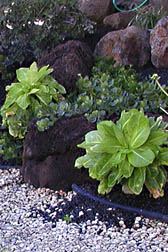
In the Garden![]()
Rick Barboza
Coastal plants have
evolved for survival
Coastal plants are usually defined as those found from right above the high-tide mark up to about 900 feet in elevation. Rainfall in this environment is generally less than 45 inches per year, although windward coasts can receive much more than that and other places such as Kalaeloa on Oahu are lucky to see any rain at all.

|
The coastal strand vegetation zone hosts the toughest conditions. In addition to those mentioned above, this area has a rocky or hard-panned substrate. Plants here have evolved to creep along the ground to avoid being blasted by high winds.
They also have tiny hairs on their leaves to reflect the sun and reduce drying out. Plants such as ilima papa (Sida fallax), pau o hiiaka (Jacquemontia ovalifolia subsp. sandwicensis), hinahina (Heliotropium anomalum var. argenteum) and nehe (Wollastonia integrefolia) have these characteristics.
Another fairly common strand plant is akulikuli (Sesuvium portulacastrum), which has succulent leaves to store moisture and a waxy coat to prevent drying.
These plants make an excellent ground cover in areas that receive full sun. They require very little watering once established. The key is to slowly acclimate them to their natural habitat -- plants purchased from a nursery were living the "good life," protected from the elements and receiving daily watering.
If you water them too much (akulikuli being an exception), they might grow too quickly and look "leggy," lose their silvery color and possibly be more affected by pests. If you live in a rainy area, make sure the plants are in the sunniest location, and reduce watering even further.
These rules also apply to coastal shrubs such as pohinahina (Vitex rotundifolia), hinahina Ewa (Achranthese splendens var. rotundata), ilima (Sida fallax), ohai (Sesbania tometosa) and the Hawaiian cotton plant called mao (Gossypium tomentosum). They all have those silvery reflective hairs, but also provide great color and contrast with their foliage and flowers.
Coastal plants that don't have the reflective hairs are akia (Wikstroemia uva-ursi), with its light greenish-gray leaves and orange and red berries, and akoko (Chamasyce celastroides), with its beautiful light greenish-blue foliage. You can plant them with other coastal plants such as naio (Myoporum sandwicense), which has dark green leaves, or naupaka kahakai (Scaevola sericea), which has lighter foliage but a nice, full look.
I've seen these plants in gardens from near the beach where they naturally grow, up to the top of Kapalama Heights and all the way back to Mililani and Wahiawa. They look great and keep the water bill low!

